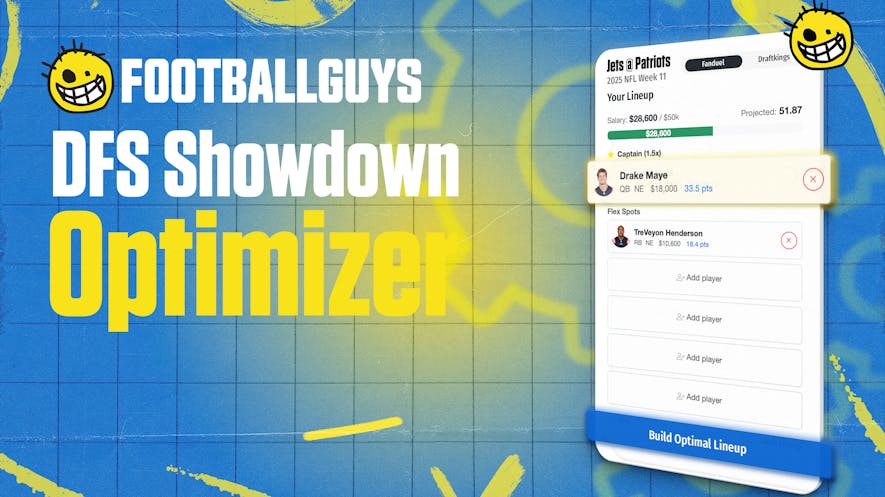There are plenty of edges in Underdog's best ball leagues that can be gained through roster structure. That structure can be macro, as previously discussed, or in the exact draft strategy used to build your teams. The latter will be the focus of today's piece, with three strategies locked and loaded for you to dominate on Underdog.
Zero RB
This strategy is written about and popularized by Footballguys' very own Matt Waldman and Shawn Siegele of RotoViz. It is founded on the concept of anti-fragility, which means team-building to take advantage of the chaos that typically occurs during the NFL season. It is easy to see why this would be desirable. Injuries and other unforeseen circumstances have a way of tanking fantasy seasons -- and this is perhaps exacerbated in a format where there are no waivers available.
Due to the number and nature of running back injuries every year, this strategy typically materializes in waiting at the position. Not only does this help to avoid catastrophic injuries to your own roster, but by creating a stable of backs in ambiguous backfields or high-value handcuff spots, those injuries will make Zero RB teams even better. Zero RB teams are almost always loaded at receiver.
From a construction standpoint, the preferred Zero RB build is:
- QB - 2
- RB - 6
- WR - 8
- TE - 2
Zero RB teams should desire to be strong at quarterback and tight end for two reasons:
- Being strong everywhere but running back limits the number of things we need to get right for our teams to pop.
- Strength at those positions allows drafters to stick to two, allowing for more capital to be spent at running back.
As was mentioned in the original Underdog edges piece, you will want to mix up the archetypes of the running backs you select. Specifically, do not take too many handcuffs. It is critical to avoid zero's in best ball since Week 1 (when Zero RB teams are weakest) counts the same as Week 13 (when Zero RB teams should be stronger due to in-season chaos).
Modified Zero RB
Even if Zero RB is your preferred strategy, there are times where deviating slightly will make sense while still maintaining a hyper-fragile structure. Specifically, there are a few workhorse running backs that it may not be wise to skip in favor of receivers. For example, even the most ardent supporter of Zero RB would not recommend taking Tyreek Hill over Christian McCaffrey at the 1.01. These running backs are so special that it is worth taking on some fragility in Round 1.
To underline that point more clearly: Alvin Kamara, Derrick Henry, and Dalvin Cook all scored at least 315 points in half-PPR formats in 2020. No other running back had more than 240. Having one of these unicorn backs is a tremendous edge in fantasy. Here is the preferred construction:
- QB - 2
- RB - 5
- WR - 9
- TE - 2
Modified Zero RB teams expect to have one running back slot accounted for week-in and week-out, so it is reasonable to spend one less pick there in the draft. That selection is defaulted to another receiver but could be used on an additional quarterback or tight end if no high-end players were selected early in the draft.
It should also be noted that this is not the same as Anchor RB or Hero RB, which is being popularized a bit this season (consider that strategy 2.5). That strategy is more about just building around a single running back -- which sounds similar but ignores who that back is -- and is not necessarily intended to be an anti-fragile build. This is a somewhat semantic difference, but the intent is important when drafting, so it is important to keep in mind. It would be best to have an idea of which backs have dominating upside when applying modified Zero RB.
Hyper-Fragile RB
This is the antithesis of Zero RB, but an extreme strategy that can still pay dividends in best-ball leagues. This strategy is built upon a few core tenants:
- Running back is inherently fragile
- If high-end backs get hurt, those teams have a difficult time winning
- It is more valuable to transfer other draft capital to the other positions than insuring those running backs
- When high-end backs stay healthy, they can dominate
Though it requires taking on more injury risk, a hyper-fragile approach can yield an excellent ceiling. Winding up with two or three running backs consistently producing quality scores is a huge edge in fantasy. And similar to our approach to the onesie positions in other strategies, taking backs early limits the total amount of capital that needs to be spent there. Weekly variance at running back is not nearly as large as it is at receiver.
Hyper-fragile constructions typically use this as a base:
- QB - 2
- RB - 3
- WR - 9
- TE - 2
With 16 spots accounted for above, drafters have some optionality to fill out the rest of the roster. If there is strength at quarterback and tight end, then you could take up to 11 receivers in a hyper-fragile build -- looking to make up for a lack of elite receivers with depth and variance. It is also possible to take six total quarterbacks and tight ends if needed.

